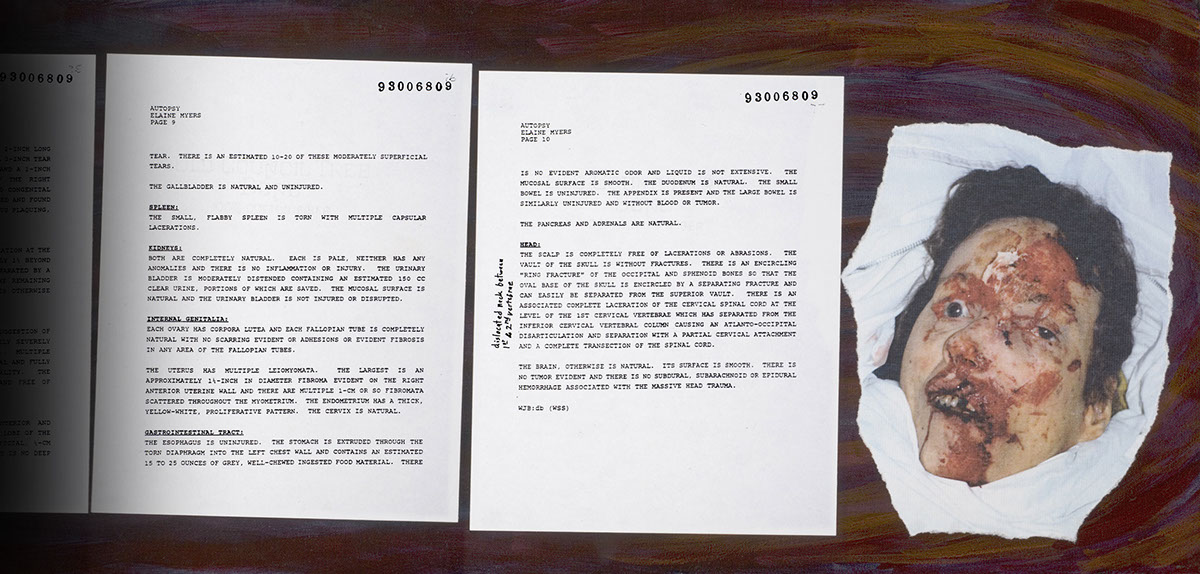All photographs, text, and graphics in this website are © David Lee Myers
Site updated
23 February 2021
Perspective
Quite naturally this rough material will be part of how you know and understand me. Nevertheless, these events do not define me. With the exception of the one brutal event, my life is wonderful.
Decades each of two satisfying marriages, of classic black and white photography, of community history interviewing, photography, and writing, of teaching college photography, and of color photography on landscape, abstract, and natural history themes. Thirteen years in public office wrestling with electric utility policy in the turbulent 1980s. A decade of playing in a semi-professional classical chamber music group. A published book on butterflies.
— David Lee Myers, 2021
Art, Media, and Community
The goal is always to help people understand and improve our behaviors, to develop a better, more humane society. Many of us find that our own hurts are easier to bear when we believe that we are making a valuable contribution to society and that we are, in fact, responding well to circumstances. At best this can provide a degree of comfort and grace even when we would never choose or approve of the situation.
I made and exhibited art work, below on this page.
— My 1994 students responded with courageous work of their own, including Ruth Doumit’s project on breast cancer and healing—life-size clay torsos with surgery, and photographs of the emotions from discovery through family support and healing.
— Cathy Zimmerman wrote a sensitive, comprehensive article about the exhibit and my experiences for The Daily News in Longview, Washington.
• Elaine’s sister Betty wrote an article Life After Death published in the San Jose Mercury News which I illustrated, and with which we were all well pleased. But Ladies Home Journal chose drama over accuracy and badly misquoted Betty in a title.
Spencer Heinz interviewed our family for a thorough and deeply understanding article in Portland’s Oregonian, focusing especially on the mediation with the drunken driver.
• Several of us did TV shows—Carnie Wilson, Save Our Streets, and ABC 20-20. Carnie worked live, and ran out of time to do what she intended. Save Our Streets showed a satisfying part of our healing attitude, but did not convey the crucial role of mediator Marty Price. Jeff Diamond and Minda Allarde, with anchor Tom Jarrell of ABC 20–20 quickly conveyed enough understanding, sensitivity, and humanity for me to trust them and tell things I had always held back—and their final program rewarded my trust. But their interview segments with Marty Price and Betty Menkin were bumped at air time by coverage of the Columbine High School massacre. Notwithstanding some disappointments, these added up to a valuable contribution to society.
My Art Work — Drunken Driving Death
I wanted to memorialize Elaine Serrell Myers' death in the collision with a drunken driver by giving the community a chance to be more aware of such events and do more to avoid future ones. My medium is photographically based visual art, so that's what I made.
The works are acrylic collages of laser-printed photographs and document copies, and some paint, on canvas. "Drunk Driver's Target" shows a very alive Elaine as if seen from the driver's seat of a car, with a target on her. The second piece, "Autopsy of a Drunk's Victim" exhibits the ten page autopsy report detailing the destruction of her body and life, bookended by photographs of her vibrantly alive and then her death face.
These art pieces were first exhibited in a Faculty Show at Lower Columbia College, Longview, Washington, in February 1994, where I was teaching. Gallery Director Trudy Woods masterfully presented the works in a way which gave viewers a choice of whether to view the Autopsy piece, and if so, whether or not to lift the veil and see the death face. Many people looked, many others did not. The works have been exhibited a half dozen more times.

Installation, Lower Columbia College
Trudy Woods, Gallery Director.
From the central gallery area, viewers saw this nook with the very visible "Drunk Driver's Target" and a warning sign so they would turn around the corner to "Autopsy" only if they chose to engage the rough content.
Drunk Driver's Target
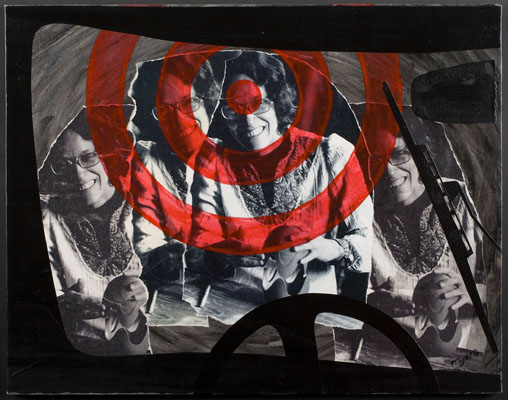
Autopsy of a Drunk's Victim
Those who read the warning sign and wanted to enter, did so. Inside, the Autopsy piece was on their right. It's framed in two five foot sections, with a veil of black bridal lace hanging over the death face.
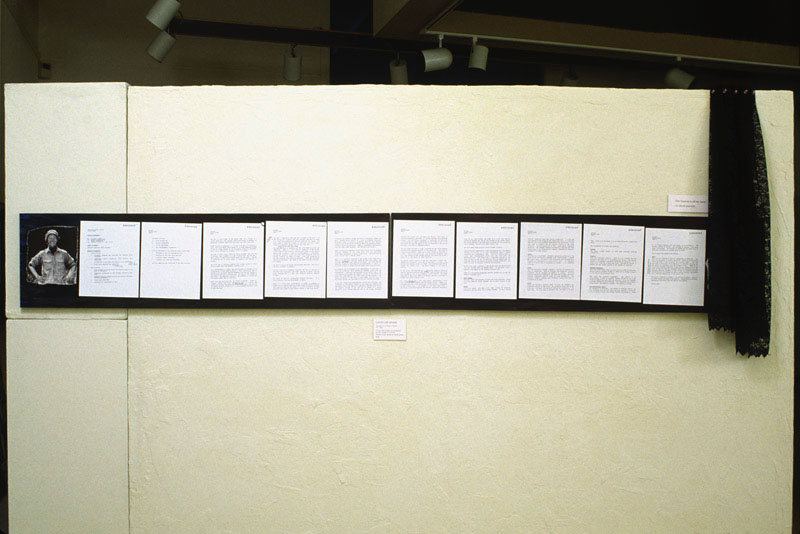
Some chose to lift the black bridal veil and view the death face. Others did not.

Larger versions of the Autopsy artwork are at the bottom of this page.
They display wider than the rest of this web page, and might not fit on your device.
High resolution versions may be requested. Contact Information.
Value of the Art Exhibition:
Viewer's Comments
By exhibiting the works, I stimulated people to think more realistically about drunk driving death and about their own behavior. Some people wrote in a comment book that they were re-evaluating their behavior. A few objected to the exhibit.
“David,
Very powerful stuff. I’m having a difficult time searching for the words to say. I’ll have to think about this for some time I guess, that’s just the point isn’t it?
—Tim Karnoski” March 1994
“David,
I am so proud of you to show this art piece to the public. I miss Elaine very much and I share in your grief. It’s a struggle to go on with life after such a great loss. I too have made art concerning my son’s murder, but not yet brave enough to show it. Thanks for giving me courage through your sorrow. This display will always be with me.
—Bonnie Long Lindsay” March 9, 1994
“David,
Words are really cheap... Thank you for sharing your agony. It’s very personal and healing to anyone who has experience grief, all of us. [ The three dots are the writer’s expression, not my editorial elipsis.]
Joe Hobson” (?) March 1994
“Dear David,
Thank youfor sharing. thank you very much. You have helped me with my grief and anger over Elaine’s death.
—Leslie Johnson (a Master Recycler/Composter)” March 8, 1994.
“David,
I am so sorry that you have to go through this pain. I understand your need to get through this and heal. It has been a year since my brother Roger Buton Jr. and his wife Michelle were killed by a drunk driver. I find myself feeling the same way you do. Sometimes I feel that I can’t go on but people like you give me hope that I’m not the only one fighting this war against drunk driving. Keep your head up and remember you’re not alone. You have a lot of courage! You’re in my prayrers. God Bless You
—Love — Kim Leile” (names ?)
“I am a young man who occasionally drinks and I have friends who drink. Your art has influenced me in such a way that I will give more thought about what I do on the weekends. And I will help my friends with the decision to do something else than drinking. I am very sorry.
—Student” March 8, 1994
“I am profoundly affected.
I feel like I share this grief and will be different than I was before I read this autopsy. I know that I’ll be talking to people about preventing tragedies and changing the way I think when I get behind the wheel.
—Mary Altenheim” March 3, 1994.
“David,
I am so sorry for your pain & loss. I am also thankful that, as you said in your own words, this is a healing process. My wish is that your healing process can be used to help others also. To stop this senseless pain by getting people to know and understand what they do to others, (and themselves), when they get behind the wheel of a car (or anything) drunk. I was warned of the gravity of your work, and made a decision to view it anyway. It has been a very sad and enlightening experience. I am sorry for your loss, you obviously loved her very much.
—A stranger but a friend, Renita Misner” February 23, 1994.
“I am sorry for your loss, however you were not the only victim. The drunk driver who killed your wife has two young children and a family who were also affected by this tragedy. Those children will be grown women possibly with their own families someday and they will not know their mother. I’m not excusing what she did, however, your article in the newspaper has caused a lot of needless grief and suffering for her family. Especially the two young children. Perhaps you should keep that into consideration.
You were not the only victim.”
—[unsigned] March 9, 1994
“No matter how many times I encountered the word, I could not convince my mind that “tears” meant “tares” and not “teers.”
So often I have wondered, and been unable to comprehend, how death actually occurs in a car accident; what radical tearing and wrenching goes on, beyond the imagination of the survivors. We are a society too distant from the untimely deaths that we cause by our shortcomings, and I thank you for having the courage to loosen your protective, reflexive grip on the details of your wife’s death to share the grim reality of it with the living.
Thank you—you have made a real difference already. Also, I love the black & white portrait of Elaine—she was and is a model human being.
It was very appropriate to lead up to the autopsy photo with the entire report, with all of its garbled, distancing words in medical jargon.
The image is golden at, from every direction
—Peace, J. White, Kelso” March 1994
“This is a very necessary and moving expression.”
—Judy Faulkner, Mental Health Therapist & Piano Teacher” March 1994
“I think it’s a good wake up call. People need to see this. I had a drunk friend stabbed to death in Mint Valley Apartment Complex parking lot. His aorta was severed. The morticians put so much makeup on him, that it flaked off, and he was blue. When he was stabbed his blood alcohol level was 0.2. I hope I never have to see this again, but I know I will, whether it be a drunk driver, murder victim, or domestic violence.
—Andréa Gregg” March 10, 1998
“Thank God I don’t drink anymore. Hearing from Barbara Morris and remembering that I drove drunk a few times makes me so grateful I stopped. I haven’t touched a drop in 18 years. Learning to deal with problems is much better than drowning them.
—Sherry” March 10, 1998
Scholarly and Professional Response
• A 1994 M.A. thesis in museum studies, Exhibiting the Unexhibitable:An investigation of design techniques used to guide, orient, and inform visitors in controversial exhibitions, by Jennifer Morgan at JFK University in San Francisco studied my Drunk Driving Death works.
• The University of Alaska English Dept.’s award for best undergraduate research paper went to Avenue Marie Campala for Terministic Screens and Being Seen: Visual Rhetoric Looking Back at You, in 2009.
• The works were shown at Victim Offender Mediation Association national conventions in Fort Worth, Texas, 1996, and Portland, Oregon, 2001-the latter accompanied by my presentation A role for Art in Restorative Justice.
• The works were shown at several more community and college events.
Larger versions of the Autopsy artwork
High resolution versions may be requested. Contact Information.
Autopsy of a Drunk's Victim, left-hand panel of the diptych
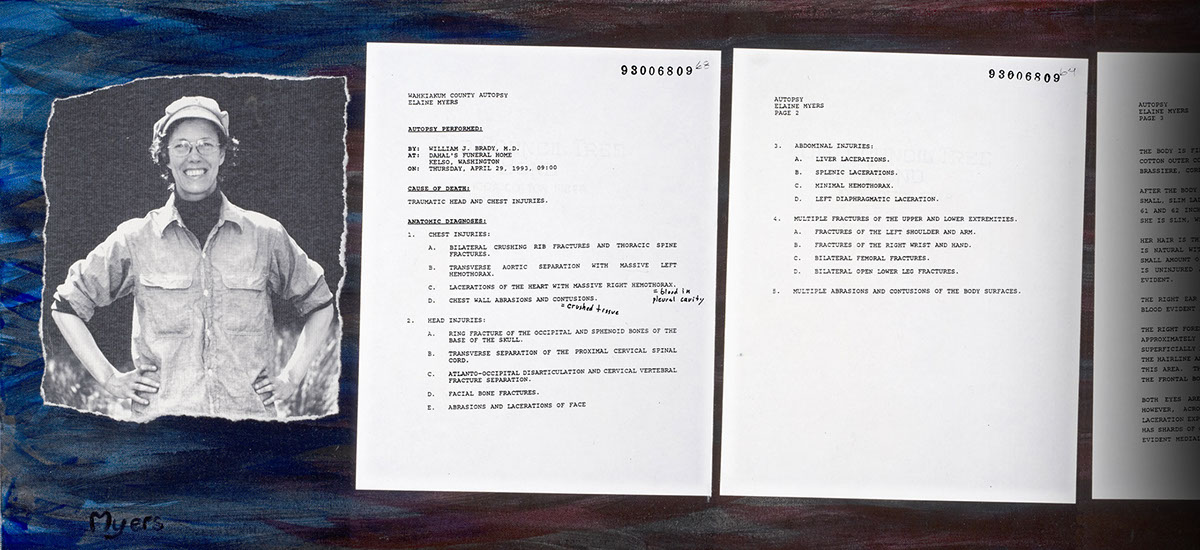

Autopsy of a Drunk's Victim, right-hand panel of the diptych — Draped version partly concealing the death face
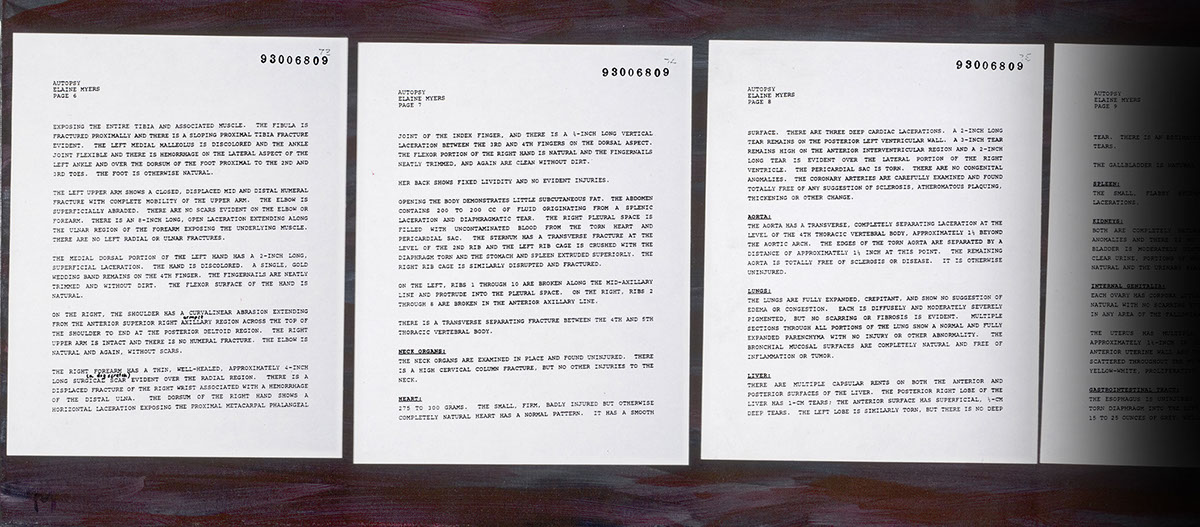
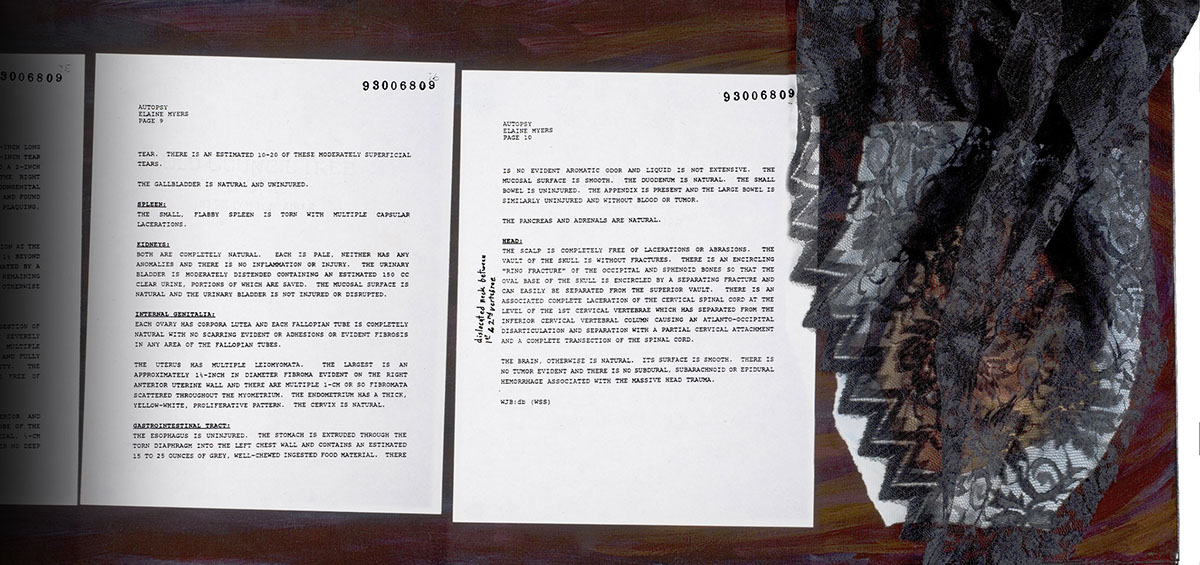
Please consider whether you choose to see the undraped death face.
If you wish, scroll down to see the undraped death face.
down
down
down
down
down
down
down
down
getting close
Autopsy of a Drunk's Victim—right hand panel of a diptych —the death face, plainly visible.
